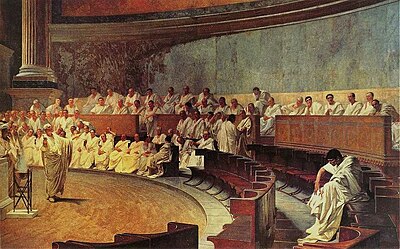Our website is made possible by displaying online advertisements to our visitors.
Please consider supporting us by disabling your ad blocker.
Roman Senate


The Roman Senate was the longest-lasting institution in Ancient Rome. It began in the first years of the city, which was supposedly founded in 753 BC. It survived the Roman Kingdom (753 BC–509 BC), the Roman Republic (509 BC–27 BC), the Roman Empire (27 BC–395 AD) and the fall of the Western Roman Empire (395–476 AD).
The Senate started as an advisory council of elders. The word "senate" came from 'senex' meaning "old man". The Senate reached its peak in the middle Republic, when it was the most powerful body in Rome. The Senate lost much of its power in the first period of the Empire, known as the Principate.
After Diocletian, when the centre of government was moved out of Rome, the Senate became just a municipal body. The influence of the old idea lived on, and Constantine II set up a Senate in Constantinople.
Previous Page Next Page


